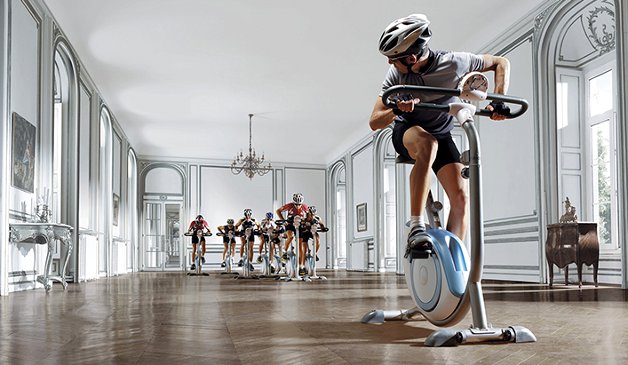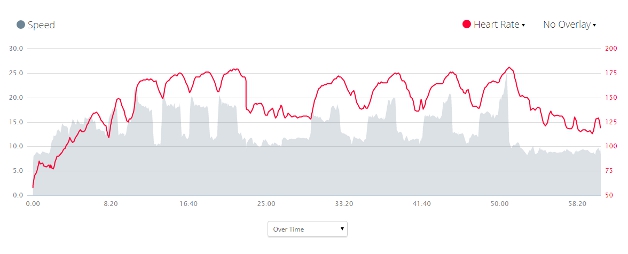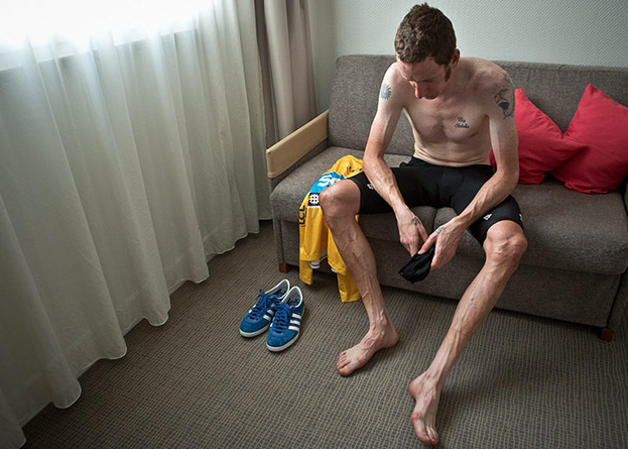Author
 Seven seconds. I spent eight weeks training to be seven seconds quicker. Ha! Yet I don’t question the futility of my existence. Well, no more than usual. I’m pleased, satisfied with my progress and my new hill climbing prowess.
Seven seconds. I spent eight weeks training to be seven seconds quicker. Ha! Yet I don’t question the futility of my existence. Well, no more than usual. I’m pleased, satisfied with my progress and my new hill climbing prowess.
 First, whilst I recommend Carmichael’s method, I’m not so sure about the book, which is a padded introduction to the acronym filled world of interval sessions. If you’re new to training it will help you understand the various concepts but you can also do this by reading around the internet quite easily.
First, whilst I recommend Carmichael’s method, I’m not so sure about the book, which is a padded introduction to the acronym filled world of interval sessions. If you’re new to training it will help you understand the various concepts but you can also do this by reading around the internet quite easily.
 The novelty of intervals wears thin quick. An hour of suffering is not something to enjoy. Climbing on the bike is the hardest part. Once on, you bury yourself in pain and loud banging music. More times than not I would finish the session euphoric. Endorphin overload.
The novelty of intervals wears thin quick. An hour of suffering is not something to enjoy. Climbing on the bike is the hardest part. Once on, you bury yourself in pain and loud banging music. More times than not I would finish the session euphoric. Endorphin overload.
 I’m quicker and stronger that’s for sure. All of my local hill climb records have been smashed and I was no slouch before I began this plan. I cannot bore you with talk of improved FTP or my VO2 max because I trained by heart rate rather than power. This might be something I’ll look into next year.
I’m quicker and stronger that’s for sure. All of my local hill climb records have been smashed and I was no slouch before I began this plan. I cannot bore you with talk of improved FTP or my VO2 max because I trained by heart rate rather than power. This might be something I’ll look into next year.
 I missed ‘normal’ cycling. The plan is so focussed it leaves little room for other rides. On the rare occasion I put in extra miles I paid for it later in the week. That said I made sure one interval session a week was completed on the road rather than the turbo. Indoor cycling is focussed but it won’t improve your core strength as you would riding on the road. Plus the road is by far the most enjoyable session.
I missed ‘normal’ cycling. The plan is so focussed it leaves little room for other rides. On the rare occasion I put in extra miles I paid for it later in the week. That said I made sure one interval session a week was completed on the road rather than the turbo. Indoor cycling is focussed but it won’t improve your core strength as you would riding on the road. Plus the road is by far the most enjoyable session.
 Firstly I’m going to enjoy the fruits of my labour and continue smashing my way up steep hills in pursuit of seconds. The plan reckons you can sustain peak form for about 2-3 weeks if you’re lucky. Form is fleeting and I can already feel my legs emptying. I’m also looking forward to some ordinary riding with no intervals. Hoorah!
Firstly I’m going to enjoy the fruits of my labour and continue smashing my way up steep hills in pursuit of seconds. The plan reckons you can sustain peak form for about 2-3 weeks if you’re lucky. Form is fleeting and I can already feel my legs emptying. I’m also looking forward to some ordinary riding with no intervals. Hoorah!
https://humancyclist.wordpress.com/2015/12/13/time-crunched-cycling/
 Seven seconds. I spent eight weeks training to be seven seconds quicker. Ha! Yet I don’t question the futility of my existence. Well, no more than usual. I’m pleased, satisfied with my progress and my new hill climbing prowess.
Seven seconds. I spent eight weeks training to be seven seconds quicker. Ha! Yet I don’t question the futility of my existence. Well, no more than usual. I’m pleased, satisfied with my progress and my new hill climbing prowess.
Two months ago I began Chris Carmichael’s Time Crunched Training Plan (TCTP) for new competitors. This was back when I was a slower rider. Now I’m a whopping seven seconds quicker up each of my two of my local hills, my previous PBs set as a man two years younger than I. Geez, I sound like a TV infomercial.
This of course is just one measure. There are many others.
My journey began when I decided to give up monster weekend rides and begin training proper. Before I knew it I was huffing and puffing on a turbo trainer in my hallway. Glamorous eh?
After completing a 4 week Strava training plan I developed a taste for the joy of post-interval sickness. I stumbled across the TCTP although I’d seen talk of such cycle cramming for many a year. This was late autumn, not the best time to begin a two month training program.
Starting so late in the year I had already failed the first test of Training Club™. Always ride with a specific goal in mind. Yet my training was far from aimless. With one eye on next year, I wanted to learn about my body and understand how it would respond to the stress of training. Plus I might even get quicker. Bonus.
The training plan

Planned training (yellow) and actual training (red)
A new language
SS 3×10. PFPI 4×2. OU 3×12. (2U, 2O). These codes dictated my evenings. I’m not going to describe the sessions in detail but if you’re interested here’s an excellent reference sheet decoding the cycle training acronyms.
The TCTP demands three interval sessions a week plus slower endurance rides. Easy right? Not quite. Completing 6 – 7 hours training a week sounds achievable yet is challenging when you are time poor. Whilst it is relatively easy to find seven hours to ride on a Sunday, breaking this time down over the busy working week is more difficult.
Cramming intervals into the evening was challenging. Get home from work, jump on the turbo, eat, go to bed. Equally as tough were my empty weekends. The new shorter weekend ride left me with many an hour to fill yet my tired legs ruled out cycling. What to do?!
Looking back, my weekly totals were a meagre three to five hours. An hour of intervals on Tuesday and Thursdays followed by more intervals on a weekend, maybe with some endurance tacked on the end. Super time crunched.
The intervals

Obligatory interval line graph
Some intervals are more enjoyable than others although much depends on how fresh you are. Attempting any interval with fatigue is asking for trouble. Here’s a taster:
- Steady State (SS), or Sweet Spot, intervals are easy and enjoyable, working just below threshold, you never quite push yourself into the red yet you work darned hard.
- Fast Pedal (FP) intervals border on the ridiculous but are fun and a welcome change from max out intervals. One for rest days. Of sorts.
- Over Under (OU) intervals are painful. Repeatedly riding marginally above or below your threshold quickly takes its toll.
- Climbing Repeats (CR) were not part of the plan but were my weekend intervals of choice. Hey, I like variety. And pain.
- Power Intervals (PFPI and SEPI). All out time. The first (peak and fade) is when you start as hard as you can before maintaining your max power for the remainder of the interval. The latter (steady effort) is when you build steadily to max power and finish strong. PFPI are the most brutal of intervals and this might explain why they are only introduced in week seven.
- Endurance Miles (EM) not technically an interval, these slow and longer sessions in zone 2 are a relief more than anything else. Before I began this programme there would have been no way I could have ridden so slowly but with intervals in my legs I had no choice! One word of warning – don’t overdo EM sessions. They’ll leave you too tired for the intervals which is where the gains will be made.
My training plan
How did I fare? Well I skipped not a single interval session although I did change one session and cut two sessions short due to fatigue, which is difficult for my inner chimp to allow. Yet resting when tired is what the plan demands. There’s no point driving yourself deep into fatigue when you have so many more intervals lined up.
I also skipped pretty much all of the endurance sessions. I commute daily and whenever I did try a few zone two spins they left me feeling very tired for the entirety of the next week. This makes for unpleasant turbo sessions.
I gave myself two simple rules when completing the plan. Firstly, commit to the workouts 100 percent or don’t bother. The workouts are designed to stress your body. Completing them at 95 percent of the prescribed effort would defeat the purpose.
Secondly, and just as importantly, listen to your body. You know when your legs are tired so skip the session entirely to avoid building up fatigue and ruining your training plan.
Knowing when to stop is difficult but there will be several signs. Lower power, speed or heart rate could all indicate you’re in need of a rest, especially when compared to your perceived effort.
Tip. I have a little test for my legs which is a good indicator of fatigue or freshness. Stand up and then slowly bend your knees until you are squatting. Count to two then slowly stand up straight again. Count to two again. Feel your legs burning? You’re getting tired and rest is required. Works every time.
The results

A welcome by-product of training
Without aiming to, I also lost weight. I was lean before this plan but now I’m chiselled. Well, my calves are. The rest of me is just thinner! I don’t own scales so cannot say how much weight has been shed but my trousers no longer fit and I have gone way beyond the last belt hole. Christmas will fix that.
Most importantly, the plan taught me to listen to my body and stop overtraining. Gone are my tired legs thanks to balancing my efforts across the week rather than riding a single epic ride each week. I kept a training diary not for posterity but to monitor my efforts. If I feel fatigue on two successive interval sessions I cut short the second session. I then rest and plan easier sessions.
The downsides

Warning: Train too much and you’ll look like this
Fitting the training into the working week was also difficult. I have to thank my better half for accommodating me. Waiting around for a late dinner. Coming home from work to a maniac sprinting in the hallway. Enduring the porno style huffing and puffing.
Towards the end of the plan I also found it mentally challenging to climb on the turbo and commit 100 percent. I imagine such challenges will be even more difficult come light and warm summer nights.
Should you start a training plan?
Do I recommend the time crunched training plan? Certainly. If you want to ride faster and can commit to the above, then this plan works. I read many other blogs and they all agree. Just consider if such riding is for you. I can certainly see why this wouldn’t appeal to a lot of folk.
If you do take on the plan, push yourself but be flexible and listen to your body. Remember, you are not a robot. I was fairly strict following the plan but did shuffle many of the sessions to fit around that thing called life. Going forward I’ll tailor the plan further in line with my goals.
The training plan is designed as a short-term boost and shouldn’t be completed more than 2 or 3 times a year as it is both physically and mentally demanding. It’s a great way to build form for two months and count down to a big event.
What next?

The off-season awaits
Then it’s rest time. It is December after all. I’ve already missed several Christmas parties in the name of ‘form’! Actual time off the bike is required after a year in which I’ve ridden further and climbed higher than ever before.
I’ll also experiment with some less structured indoor riding courtesy of Zwift before gearing back up in the new year by trialling the more structured TrainerRoad. I may even join a few group rides to get some miles in.
One thing’s for sure, next year I shall continue to structure my rides. I already have a spreadsheet with every ride mapped out courtesy of Joe Friel’s Training Bible! The plan will be filled with intervals from this training plan which I look forward to tailoring.
There is a limit though. I love cycling too much to be so focussed. My plan will include down time and some time to discover the world on two wheels. Bring it on.
For further information log on website :https://humancyclist.wordpress.com/2015/12/13/time-crunched-cycling/





No comments:
Post a Comment